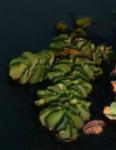Latin name
Salvinia molesta D.S. Mitch.
Family
Salviniaceae
Common name(s)
Water fern
Synonym(s)
Salvinia auriculata Aubl.
Geographical distribution
South and Southeast Asia: India, Indonesia, Malaysia, Philippines, Sri Lanka, and Thailand.
Rest of the world: Australia, Mauritius, and Papua New Guinea.
Morphology
A free-floating, annual or perennial, mat-forming freshwater fern, up to 30—cm—long with slender floating rhizome.
Stem: horizontal, hairy, much branched, and with short internodes.
Leaf: leaves (fronds) in whorls of 3, with upper two folded and floating and lower one submerged, divided, and with root-like filaments; floating leaves broadly elliptic, not exceeding 3—cm—long; upper surface with numerous compound hairs, lower surface without hair or with just simple hairs on or near the midrib.
Sporangia: microsporangia numerous and normally contain 64 microspores; short-stalked megasporangia are few: each produces 1 megaspore.
Biology and ecology
Growth rate can be faster than that of water hyacinth. The plant's basic structure includes a horizontal rhizome, each node of which gives rise to a pair of aerial leaves, which float, and a submerged root-like organ, which is actually a submerged leaf. Axillary buds found on alternate sides of rhizome. A mat forms when plants grow in crowded conditions and when internodes become short and leaves enlarge, resulting in leaves overlapping. At this stage, most of the leaf undersurface is no longer in contact with the water.
With limited nutrients, the weed is small, with flat aerial leaves, less than 15—mm—long. This stage is the most susceptible to chemical control and to phytophagous insects. Growth is favored by calm, still conditions in the water and is greatly affected by river floods, wave action, and salt water.
Propagates vegetatively and dormant buds are stimulated to grow after plants are damaged. In greenhouse studies, plant development has been shown to be complete in 30 days.
Agricultural importance
Troublesome plant because it impedes water flow in canals, irrigation channels, and drainage ditches; competes with other plants for nutritive elements, sunlight, and space; and can seriously hamper transportation. Thick mat reduces sunlight for other aquatic life.
Used as an animal feed supplement, compost, and a source of paper pulp; also useful as a bioagent for wastewater treatment.
Management
Biological control: the beetle Cyrtobagous salviniae Calder & Sands and the Chinese grass carp or "white amur" Ctenopharyngodon idella Val. are potential biological control agents for S. molesta.
Chemical control: Paraquat, diquat, MCPA, 2,4-D, diuron, diesel oil, kerosene, and gramoxone have been found effective against S. molesta.
Selected references
Auld BA, Medd RW. 1992. Weeds: an illustrated botanical guide to the weeds of Australia. Melbourne and Sydney (Australia): Inkata Press. 255 p.Baltazar F, Lopez S, Tan BC. 1987. Taxonomy and distributional notes on Philippine Salvinia molesta. Phillip. J. Weed Sci. 14:26-37.Gupta OP. 1987. Aquatic weed management. New Delhi (India):R.K. Jain, Today and Tomorrow's Printers and Publishers. 244 p.Jayanth KP, Nagarkatti S. 1987. Host-specificity of Cyrtobagous salviniae Calder & Sands (Col., Curculionidae) introduced into India for the control of Salvinia molesta. Entomon 12(1):1-6.Mitchell DS. 1978. Aquatic weeds in Australian waters. Canberra (Australia): Australian Government Publishing Service. 189 p.Moody K. 1989. Weeds reported in rice in South and Southeast Asia. Manila (Philippines): International Rice Research Institute. 442 p.Nipaney PC. 1993. World's worst weed (Salvinia): its impact and utilization. Dehradun (India): International Book Distributors. 224 p.Pancho JV, Obien SR. 1995. Manual of ricefield weeds in the Philippines. Muñoz, Nueva Ecija (Philippines): Philippine Rice Research Institute. 543 p.Pancho JV, Soerjani M. 1978. Aquatic weeds of Southeast Asia. College, Laguna (Philippines): University of the Philippines at Los Baños and Bogor (Indonesia): SEAMEO Regional Center for Tropical Biology (BIOTROP). 130 p.W3TROPICOS at http://mobot.mobot.org/Pick/Search/pick.html.
Contributors
JLA Catindig, RT Lubigan, and DE Johnson
